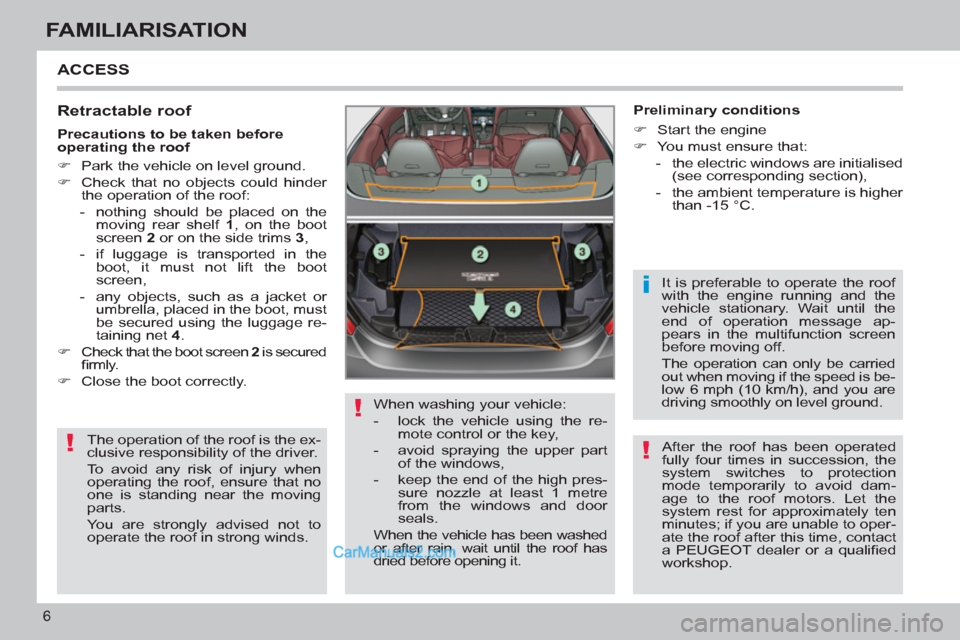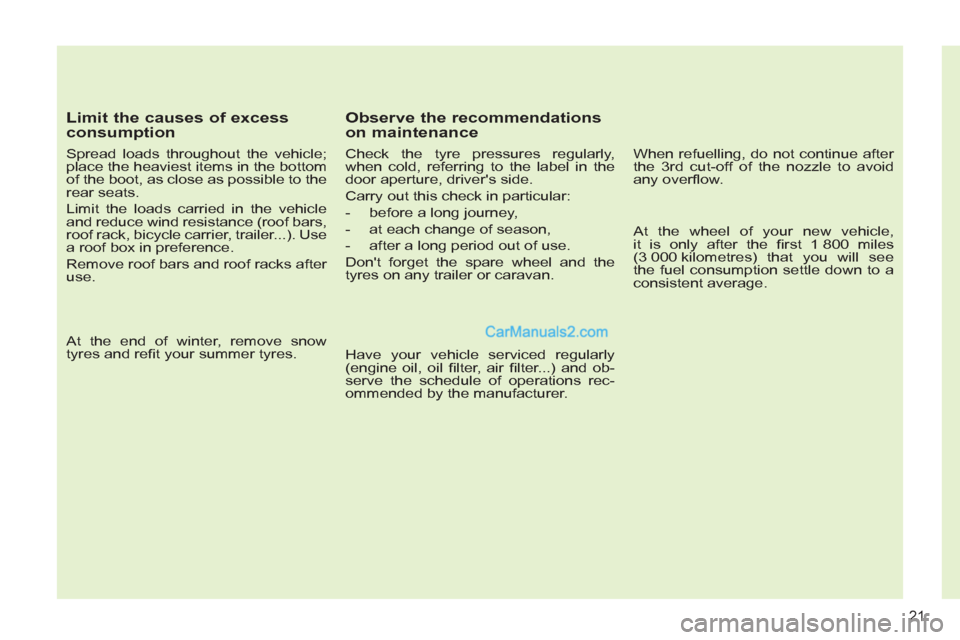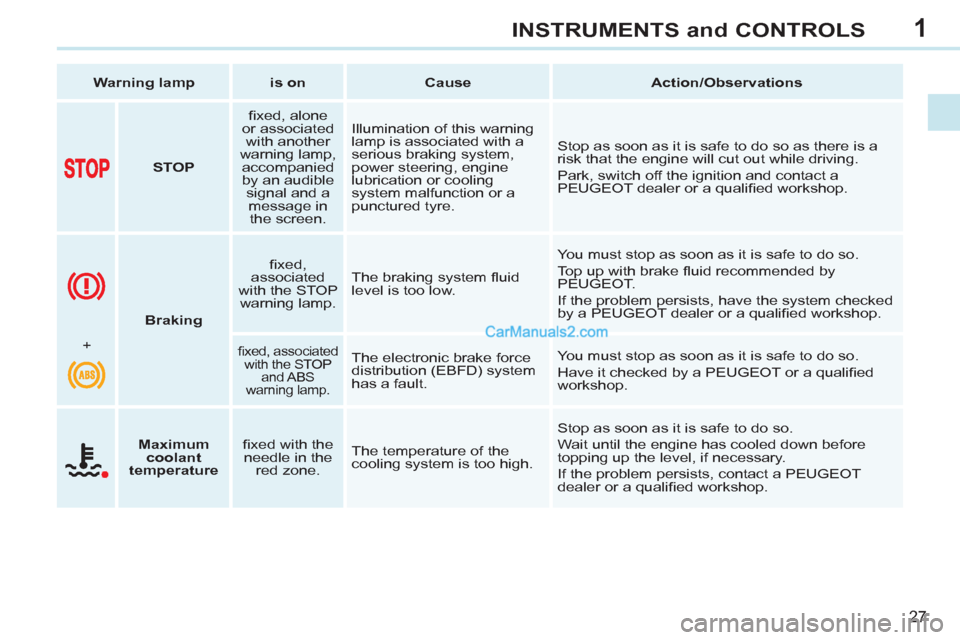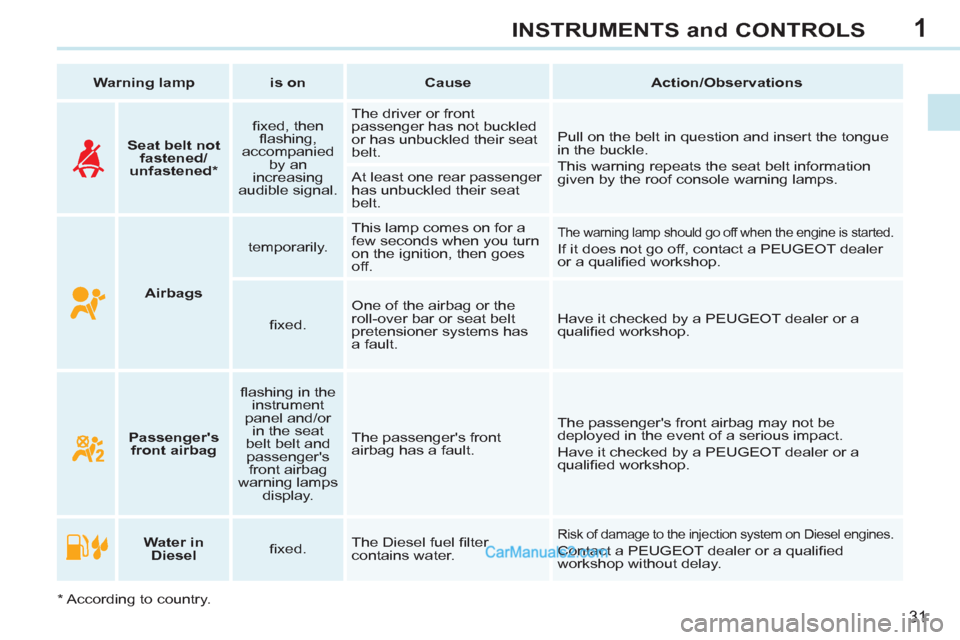2011 Peugeot 308 CC check engine
[x] Cancel search: check enginePage 5 of 292

3
CONTENTS
Direction indicators 101
Hazard warning lamps 101
Horn 102
Emergency or assistance call 102
Tyre under-infl ation detection 103
Braking assistance systems 104
Trajectory control systems 105
Front seat belts 107
Airbags 110
Child seats 114
ISOFIX child seats 119�„
�„
�„
�„
�„
�„
�„
�„
�„
�„
�„
SAFETY 101 �Π121
Parking brake 122
Manual gearbox 122
Gear shift indicator 123
Hill start assist 124
Automatic gearbox 125
Stop & Start 128
Speed limiter 131
Cruise control 133
Parking sensors 135�„
�„
�„
�„
�„
�„
�„
�„
�„
DRIVING 122 �Π136
Bonnet 138
Running out of fuel (Diesel) 139
Petrol engines 140
Diesel engines 141
Checking levels 142
Checks 144�„
�„
�„
�„
�„
�„
CHECKS 137 �Π145
Temporary puncture repair kit 146
Changing a wheel 151
Changing a bulb 155
Changing a fuse 160
Battery 166
Energy economy mode 168
Changing a wiper blade 169
Towing the vehicle 169
Towing a trailer 171
Very cold climate screen 172
Accessories 172�„
�„
�„
�„
�„
�„
�„
�„
�„
�„
�„
PRACTICAL
INFORMATION 146 �Π173
Petrol engines 174
Weights (petrol) 175
Diesel engines 176
Weights (Diesel) 177
Dimensions 178
Identifi cation markings 179�„
�„
�„
�„
�„
�„
TECHNICAL
DATA 174 �Π180
AUDIO EQUIPMENT
and TELEMATICS 181 �Π278
VISUAL
SEARCH 279 �Π282
ALPHABETICAL
INDEX 283 �Π287
Emergency or assistance 181
Peugeot Connect Media 185
Peugeot Connect Navigation 229
Peugeot Connect Sound 261�„
�„
�„
�„
7
89
1011
Page 8 of 292

!
!
i
!
6
FAMILIARISATION
ACCESS
Retractable roof
The operation of the roof is the ex-
clusive responsibility of the driver.
To avoid any risk of injury when
operating the roof, ensure that no
one is standing near the moving
parts.
You are strongly advised not to
operate the roof in strong winds. When washing your vehicle:
- lock the vehicle using the re-
mote control or the key,
- avoid spraying the upper part
of the windows,
- keep the end of the high pres-
sure nozzle at least 1 metre
from the windows and door
seals.
When the vehicle has been washed
or after rain, wait until the roof has
dried before opening it. It is preferable to operate the roof
with the engine running and the
vehicle stationary. Wait until the
end of operation message ap-
pears in the multifunction screen
before moving off.
The operation can only be carried
out when moving if the speed is be-
low 6 mph (10 km/h), and you are
driving smoothly on level ground.
Preliminary conditions
�)
Start the engine
�)
You must ensure that:
- the electric windows are initialised
(see corresponding section),
- the ambient temperature is higher
than -15 °C.
Precautions to be taken before
operating the roof
�)
Park the vehicle on level ground.
�)
Check that no objects could hinder
the operation of the roof:
- nothing should be placed on the
moving rear shelf 1
, on the boot
screen 2
or on the side trims 3
,
- if luggage is transported in the
boot, it must not lift the boot
screen,
- any objects, such as a jacket or
umbrella, placed in the boot, must
be secured using the luggage re-
taining net 4
.
�)
Check that the boot screen 2
is secured
fi rmly.
�)
Close the boot correctly.
After the roof has been operated
fully four times in succession, the
system switches to protection
mode temporarily to avoid dam-
age to the roof motors. Let the
system rest for approximately ten
minutes; if you are unable to oper-
ate the roof after this time, contact
a PEUGEOT dealer or a qualifi ed
workshop.
Page 23 of 292

21
Limit the causes of excess
consumption
Spread loads throughout the vehicle;
place the heaviest items in the bottom
of the boot, as close as possible to the
rear seats.
Limit the loads carried in the vehicle
and reduce wind resistance (roof bars,
roof rack, bicycle carrier, trailer...). Use
a roof box in preference.
Remove roof bars and roof racks after
use.
At the end of winter, remove snow
tyres and refi t your summer tyres.
Observe the recommendations
on maintenance
Check the tyre pressures regularly,
when cold, referring to the label in the
door aperture, driver's side.
Carry out this check in particular:
- before a long journey,
- at each change of season,
- after a long period out of use.
Don't forget the spare wheel and the
tyres on any trailer or caravan.
Have your vehicle serviced regularly
(engine oil, oil fi lter, air fi lter...) and ob-
serve the schedule of operations rec-
ommended by the manufacturer.
When refuelling, do not continue after
the 3 rd cut-off of the nozzle to avoid
any overfl ow.
At the wheel of your new vehicle,
it is only after the fi rst 1 800 miles
(3 000 kilometres) that you will see
the fuel consumption settle down to a
consistent average.
Page 25 of 292

1
i
23
INSTRUMENTS and CONTROLS
PETROL - DIESEL MANUAL OR AUTOMATIC GEARBOX
INSTRUMENT PANELS
Panel grouping together the vehicle
operation indication dials and warning
lamps.
5.
Small screen.
6.
Central screen.
7.
Control button.
Starts a manual CHECK and recalls
the service information.
Resets the function to zero (trip dis-
tance recorder or service indicator).
8.
Instrument panel lighting
dimmer
Adjusts the brightness of the lighting
of the instruments and controls.
Dials
1.
Rev counter.
Indicates the speed of rotation of the
engine (x 1 000 rpm).
2.
Coolant temperature.
Indicates the temperature of the
engine coolant (° Celsius).
3.
Fuel level.
Indicates the quantity of fuel remain-
ing in the tank.
4.
Vehicle speed.
Indicates the current speed of the
moving vehicle (mph or km/h).
A.
Trip distance recorder.
(miles or km)
B.
Distance recorder.
(miles or km)
C.
Engine oil level indicator,
service indicator.
(miles or km)
These two functions are displayed
when the ignition is switched on,
then disappear after a few seconds.
Displays
For more information, refer to the
paragraph which relates to the but-
ton or function and its associated
display. The following functions are displayed in
accordance with the selection.
- Warning lamps/CHECK.
- Tyre under-infl ation detection.
- Speed limiter/Cruise control.
- Gear shift indicator.
- Automatic gearbox.
-
Navigation - Guidance/Trip computer.
Page 26 of 292

1
i
24
INSTRUMENTS and CONTROLS
PETROL - DIESEL MANUAL OR AUTOMATIC GEARBOX PEUGEOT
CONNECT MEDIA INSTRUMENT PANELS
Panel grouping together the vehicle
operation indication dials and warning
lamps.
5.
Small screen.
6.
Central screen.
7.
Control button.
Starts a manual CHECK and recalls
the service information.
Resets the function to zero (trip dis-
tance recorder or service indicator).
8.
Instrument panel lighting
dimmer
.
Adjusts the brightness of the lighting
of the instruments and controls.
Dials
1.
Rev counter.
Indicates the speed of rotation of the
engine (x 1 000 rpm).
2.
Coolant temperature.
Indicates the temperature of the
engine coolant (°Celsius).
3.
Fuel level.
Indicates the quantity of fuel remain-
ing in the tank.
4.
Vehicle speed.
Indicates the current speed of the
moving vehicle (mph or km/h).
A.
Trip distance recorder.
(miles or km)
B.
Distance recorder.
(miles or km)
C.
Engine oil level indicator,
se
rvice indicator.
(miles or km)
These two functions are displayed
when the ignition is switched on,
then disappear after a few seconds.
Displays
For further information, refer to the
paragraph which relates to the but-
ton or function and its associated
display. The following functions are displayed in
accordance with the selection.
- Warning lamps/CHECK.
- Tyre under-infl ation detection.
- Speed limiter/Cruise control.
- Gear shift indicator.
- Automatic gearbox.
-
Navigation - Guidance/Trip computer.
- Vehicle parameters.
Page 29 of 292

1
27
INSTRUMENTS and CONTROLS
Warning lamp
is on
Cause
Action/Observations
STOP
fi xed, alone
or associated
with another
warning lamp,
accompanied
by an audible
signal and a
message in
the screen. Illumination of this warning
lamp is associated with a
serious braking system,
power steering, engine
lubrication or cooling
system malfunction or a
punctured tyre. Stop as soon as it is safe to do so as there is a
risk that the engine will cut out while driving.
Park, switch off the ignition and contact a
PEUGEOT dealer or a qualifi ed workshop.
Braking
fi xed,
associated
with the STOP
warning lamp. The braking system fl uid
level is too low. You must stop as soon as it is safe to do so.
Top up with brake fl uid recommended by
PEUGEOT.
If the problem persists, have the system checked
by a PEUGEOT dealer or a qualifi ed workshop.
+
fi xed, associated
with the STOP
and ABS
warning lamp.
The electronic brake force
distribution (EBFD) system
has a fault. You must stop as soon as it is safe to do so.
Have it checked by a PEUGEOT or a qualifi ed
workshop.
Maximum
coolant
temperature
fi xed with the
needle in the
red zone. The temperature of the
cooling system is too high. Stop as soon as it is safe to do so.
Wait until the engine has cooled down before
topping up the level, if necessary.
If the problem persists, contact a PEUGEOT
dealer or a qualifi ed workshop.
Page 30 of 292

1
28
INSTRUMENTS and CONTROLS
Service
temporarily,
accompanied
by a message. Minor faults have occurred
for which there is no
specifi c warning lamp. Identify the fault by reading the message
displayed in the screen:
- doors, boot or bonnet open,
- low engine oil level,
- low screenwash/headlamp wash reservoir
level,
- remote control battery fl at,
- low tyre pressures,
- saturation of the particle emission fi lter on
Diesel vehicles (see Checks - checking
levels/particle emissions fi lter).
For any other faults, contact a PEUGEOT dealer
or a qualifi ed workshop.
fi xed,
accompanied
by a message
and an audible
signal. Major faults have occurred
for which there is no
specifi c warning lamp. Identify the fault by reading the message shown
in the screen and you must then contact
a
PEUGEOT dealer or a qualifi ed workshop.
Warning lamp
is on
Cause
Action/Observations
Engine
autodiagnosis
system
fl ashing. The engine management
system has a fault. Risk of destruction of the catalytic converter.
Have it checked by a PEUGEOT dealer or a
qualifi ed workshop.
fi xed. The emission control
system has a fault. The warning lamp should go off when the engine
is started.
If it does not go off, contact a PEUGEOT dealer
or qualifi ed workshop without delay.
Page 33 of 292

1
31
INSTRUMENTS and CONTROLS
Warning lamp
is on
Cause
Action/Observations
Water in
Diesel
fi xed. The Diesel fuel fi lter
contains water.
Risk of damage to the injection system on Diesel engines.
Contact a PEUGEOT dealer or a qualifi ed
workshop without delay.
Airbags
temporarily. This lamp comes on for a
few seconds when you turn
on the ignition, then goes
off.
The warning lamp should go off when the engine is started.
If it does not go off, contact a PEUGEOT dealer
or a qualifi ed workshop.
fi xed. One of the airbag or the
roll-over bar or seat belt
pretensioner systems has
a fault. Have it checked by a PEUGEOT dealer or a
qualifi ed workshop.
Seat belt not
fastened/
unfastened *
fi xed, then
fl ashing,
accompanied
by an
increasing
audible signal. The driver or front
passenger has not buckled
or has unbuckled their seat
belt. Pull on the belt in question and insert the tongue
in the buckle.
This warning repeats the seat belt information
given by the roof console warning lamps. At least one rear passenger
has unbuckled their seat
belt.
*
According to country.
Passenger's
front airbag
fl ashing in the
instrument
panel and/or
in the seat
belt belt and
passenger's
front airbag
warning lamps
display. The passenger's front
airbag has a fault. The passenger's front airbag may not be
deployed in the event of a serious impact.
Have it checked by a PEUGEOT dealer or a
qualifi ed workshop.